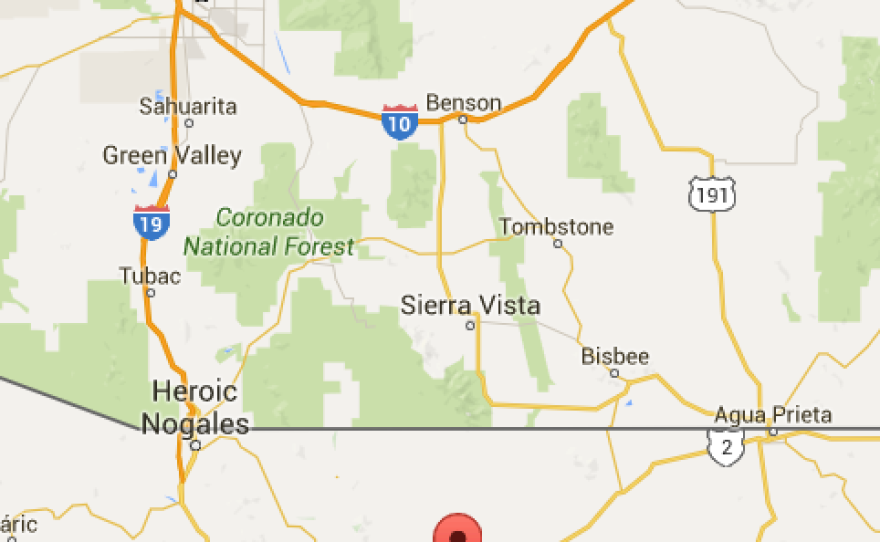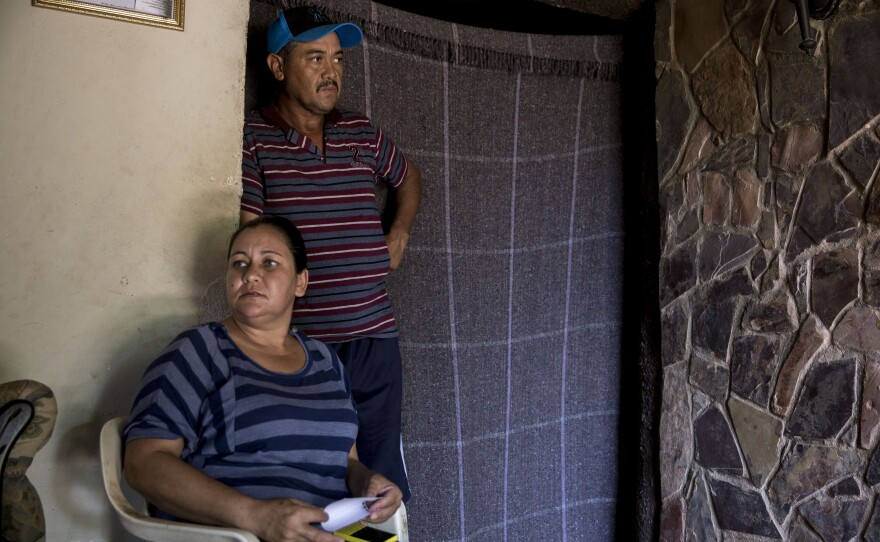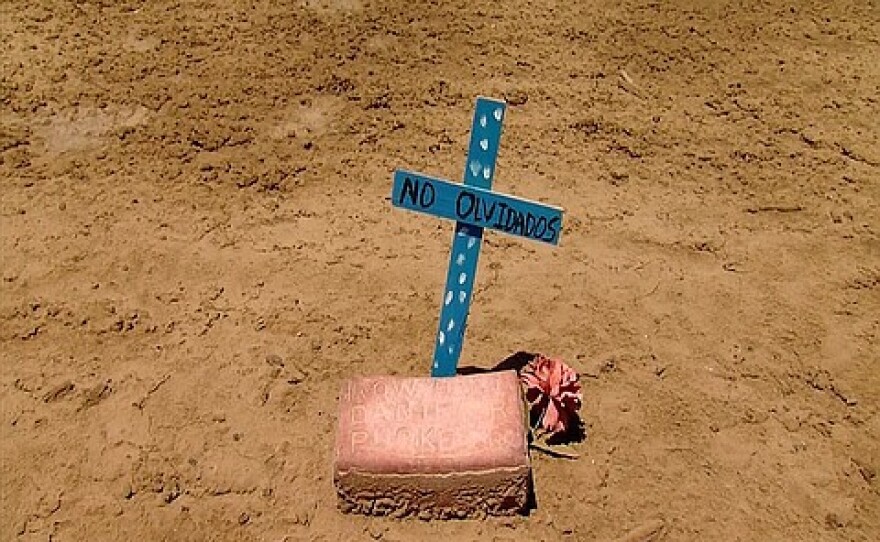
A small fan clicks and hums as Jonathan Cosillos focuses on a chemistry book at his kitchen table in Sonora, Mexico. He's working on his daily homework, but the light breeze isn't enough to keep the flies from interrupting his concentration.
It's late summer in the rural farming community, and Cosillos is still getting used to his academic routine. The soft-spoken 18-year-old from a family of five no longer works as a day laborer on a farm, as his father and brother do. But that's not by choice.
He's one of nearly 400 people the Mexican government has identified with illnesses tied directly to heavy metal contamination from a mining accident that spilled 11 million gallons of toxic chemicals into the Sonora River.

The Buenavista del Cobre copper mine is owned by Grupo México, a mining conglomerate with sites across Latin America and the U.S. It was fined nearly $1.5 million for more than 50 violations identified by the Mexican government relating to the spill.
It's been more than a year since the spill, but new medical cases continue to emerge. Researchers and environmental experts in Mexico are now warning that the government’s slow response, combined with outdated water quality standards, have placed the population under unnecessary risk.
RELATED: Impacts To Health, Livelihood Continue 1 Year After Toxic Mine Spill In Mexico
Cosillos was working at a cucumber farm when the contaminated river flooded. He wasn't aware of the risks as he and others rushed to save their harvest, wading through toxic water and drinking from the wells supplied by the river.
About a week later, he started feeling sick.
"I didn’t want to go to work, but I didn’t want to lose the job,” Cosillos said. "I knew my family was struggling. I wondered if it had anything to do with the river spill.”
It did. But it took nine months for him to get that answer.
The government responds
When Mexican officials learned about the spill, they immediately closed all water wells within the seven municipalities near the river to prevent further contamination. The spill released a copper acid sulfate solution, which includes heavy metals such as aluminum, manganese and arsenic.
Mexican officials said that they immediately sent mobile teams of doctors into communities to identify affected families. But the doctors weren't able to visit with every family.
Cosillos and his family didn't know about the response, so they went to their local hospital where he was misdiagnosed. The doctors sent him home with medicine for parasites.
It would be four months before his family was visited by Mexican health authorities who were looking for victims of the spill. They found Cosillos after they reviewed his medical files from the local hospital.
It then took another month before doctors brought Cosillos to Hermosillo, the state capital, to get his blood tested for heavy metals. His health got worse as Cosillos and his family waited for the results. The results never came.
“There were times that he wouldn’t tell me (he was in pain). I saw him grabbing his stomach and curl up his body,” said Cosillos' mother, Blanca Ruiz, 38.
She said that at one point he was in so much pain that he wanted to start shopping for coffins. He didn't think he was going to make it.
“After the spill, many people went to their health center and it wasn’t possible to detect them,” said Joel Lopez Villagomez, the director of a temporary treatment center that opened in March 2015.
The center, known as UVEAS, operates out of a home that was converted into a small treatment facility. It's a temporary location because the Mexican government has plans to construct a permanent structure later this year.
It was here where Cosillos finally got the answers he was looking for. It had been nine months since he first became ill.
His blood analysis showed that he had levels of manganese above acceptable levels.
Manganese is a heavy metal that can have a serious impact on the nervous system if a person is exposed over prolonged periods of time, according to Hector Duarte Tagles, an environmental health specialist at the University of Sonora.
“There’s a high risk if people begin their treatment late,” Duarte Tagles said. "The longer some contaminants are in the organism, the more difficult it is to get rid of them."
Adolfo Garcia Morales, then a Sonora delegate to the Mexican Ministry of the Interior, said officials actively searched for patients throughout the Sonora River Basin. To date, the government says it's screened more than 10,000 residents.
"We've put a lot of emphasis on providing immediate care," Garcia Morales said. "And I know for sure that we've given immediate care when people agreed to receive treatment."
Morales said there wasn't a single person who had tests conducted that didn't receive the results.
“The epidemiology unit opened recently, but that doesn’t mean that we haven’t been providing care to the population,” he said.
The new clinic, UVEAS, will continue testing its patients every three months, for up to 15 years.

But according to Cosillos's mother, Blanca Ruiz, the nine months it took for her son to get tested and begin treatment was unacceptable.
“If the government knew what was happening, why didn’t they take actions right away - right away,” Ruiz said.
Mexican norms for heavy metals 2.5 times international standards
A year after the spill, the official statement from the Mexican government is that the river is clean and that most water wells are too. Academics and scientists are challenging that, after more cases like Cosillos' are coming to light.
Contamination from the spill has highlighted outdated water quality standards in Mexico, possibly endangering the population according to some researchers.
Reina Castro Longoria, a professor and researcher of marine ecology at the University of Sonora, conducted independent studies of the Sonora River after receiving calls from residents. She said they had health problems such as skin spots, rashes and hair loss. This is in addition to severe diarrhea and other digestive problems.
Castro Longoria took water samples from the Sonora River and five water wells nearby in July 2015. She had the samples analyzed at a laboratory and found elevated levels of arsenic and aluminum.
In Mexico, the norm for arsenic is 2.5 times the acceptable limit for drinking water when compared to standards from the World Health Organization and the Environmental Protection Agency in the U.S.
“People are still drinking water from the pipes reaching their home,” Castro Longoria said. “They’re getting sick from the water.”
Castro Longoria said the high levels of toxins are acceptable under Mexican regulations, but would be considered dangerous according to international standards.
She tested six residents that presented symptoms of arsenic poisoning and found a presence in their blood 19 times the acceptable human levels when compared to international standards.
Longoria presented her findings to the Mexican government in August 2015, to argue that the Mexican norms for heavy metals should be updated to match international standards.
Adolfo Garcia Morales, the former delegate to the Sonora Mexican Ministry of the Interior, said he met with the academics to discuss the findings. He said that the federal government has been working to update the norm for several toxins and heavy metals found in the river.
The proposal is still pending.
He also denied that Mexico’s water quality standards have put people’s health at risk.
"I couldn’t say that it is negligence. I’m not an expert on the subject. But what is true is that we live in a state where there is a rule of law. And while the law we have might not be the best, it is after all the one that is in effect,” Garcia Morales said.
On November 5, the Mexico Ministry of Environmental and Natural Resources (Semarnat) said in a press release that the water samples taken over the past nine months from the Sonora River don’t show any heavy metals above Mexican standards.
Grupo México has since resumed its mining operation after the Mexican government forced a partial closure immediately following the spill. The company also was compelled to establish a $150 million trust fund to help offset the damages to farmers and individuals.
For Cosillos, who now receives treatment at UVEAS, his afternoons are spent studying. He received the equivalent of $1,400 from the trust fund.
Blanca Ruiz, his mother, said the money is just enough to pay for his first year back to school. She's happy that he's once again getting an education, but she wishes it was under different circumstances.
“We’re sick and we don’t even know what will happen at the end of the day...they can say it’s all good, and that he is improving, but truth be told, we don’t know,” she said.






